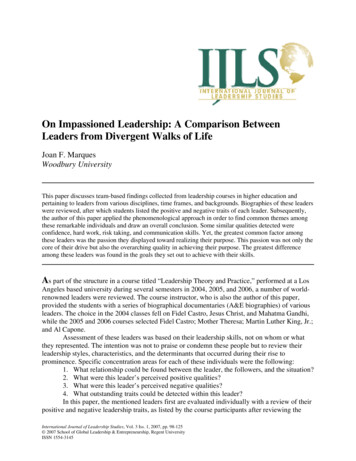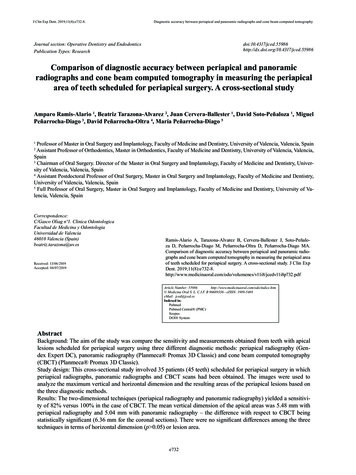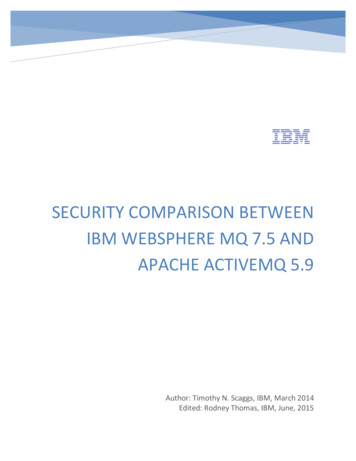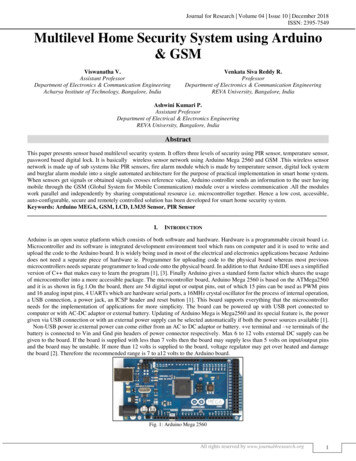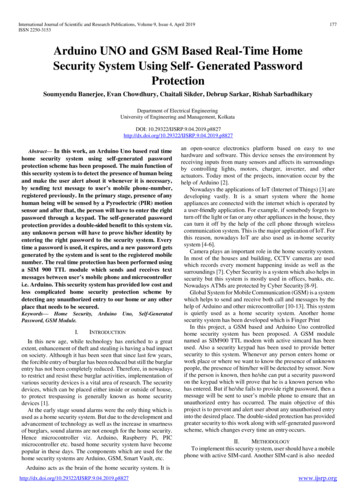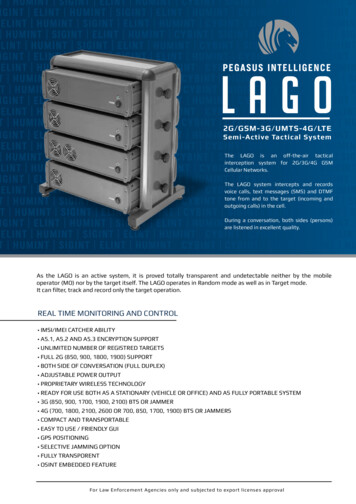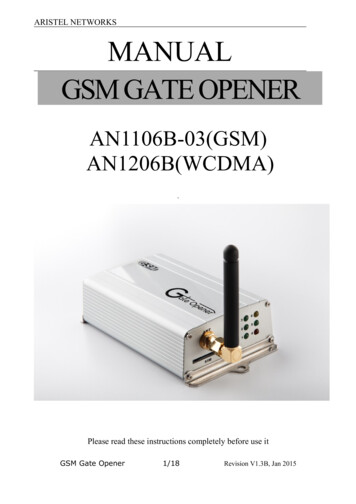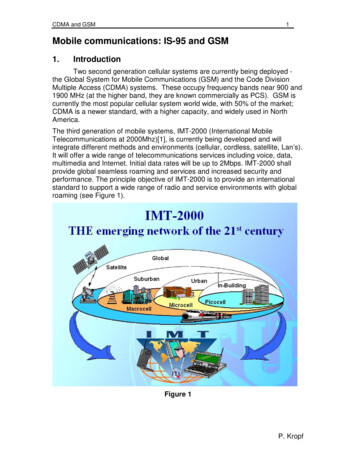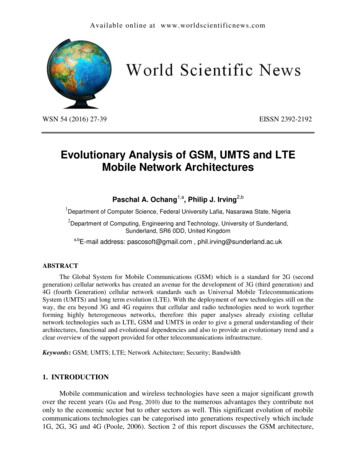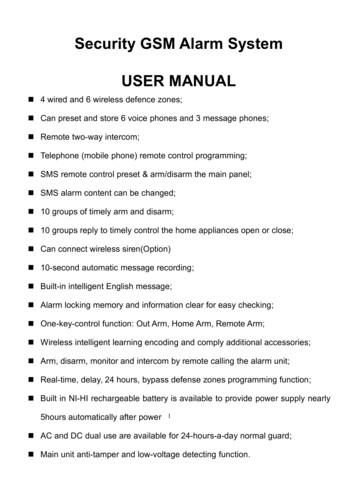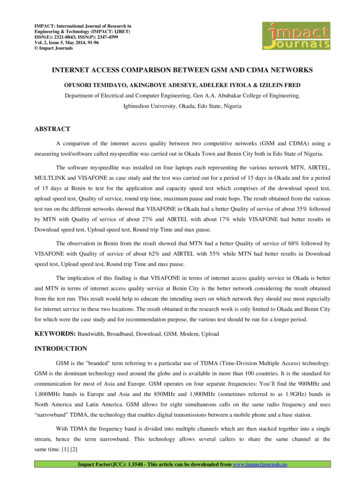
Transcription
IMPACT: International Journal of Research inEngineering & Technology (IMPACT: IJRET)ISSN(E): 2321-8843; ISSN(P): 2347-4599Vol. 2, Issue 5, May 2014, 91-96 Impact JournalsINTERNET ACCESS COMPARISON BETWEEN GSM AND CDMA NETWORKSOFUSORI TEMIDAYO, AKINGBOYE ADESEYE, ADELEKE IYIOLA & IZILEIN FREDDepartment of Electrical and Computer Engineering, Gen A.A. Abubakar College of Engineering,Igbinedion University, Okada, Edo State, NigeriaABSTRACTA comparism of the internet access quality between two competitive networks (GSM and CDMA) using ameasuring tool/software called myspeedlite was carried out in Okada Town and Benin City both in Edo State of Nigeria.The software myspeedlite was installed on four laptops each representing the various network MTN, AIRTEL,MULTLINK and VISAFONE as case study and the test was carried out for a period of 15 days in Okada and for a periodof 15 days at Benin to test for the application and capacity speed test which comprises of the download speed test,upload speed test, Quality of service, round trip time, maximum pause and route hops. The result obtained from the varioustest run on the different networks showed that VISAFONE in Okada had a better Quality of service of about 35% followedby MTN with Quality of service of about 27% and AIRTEL with about 17% while VISAFONE had better results inDownload speed test, Upload speed test, Round trip Time and max pause.The observation in Benin from the result showed that MTN had a better Quality of service of 68% followed byVISAFONE with Quality of service of about 62% and AIRTEL with 55% while MTN had better results in Downloadspeed test, Upload speed test, Round trip Time and max pause.The implication of this finding is that VISAFONE in terms of internet access quality service in Okada is betterand MTN in terms of internet access quality service at Benin City is the better network considering the result obtainedfrom the test run. This result would help to educate the intending users on which network they should use most especiallyfor internet service in these two locations. The result obtained in the research work is only limited to Okada and Benin Cityfor which were the case study and for recommendation purpose, the various test should be run for a longer period.KEYWORDS: Bandwidth, Broadband, Download, GSM, Modem, UploadINTRODUCTIONGSM is the "branded" term referring to a particular use of TDMA (Time-Division Multiple Access) technology.GSM is the dominant technology used around the globe and is available in more than 100 countries. It is the standard forcommunication for most of Asia and Europe. GSM operates on four separate frequencies: You’ll find the 900MHz and1,800MHz bands in Europe and Asia and the 850MHz and 1,900MHz (sometimes referred to as 1.9GHz) bands inNorth America and Latin America. GSM allows for eight simultaneous calls on the same radio frequency and uses“narrowband” TDMA, the technology that enables digital transmissions between a mobile phone and a base station.With TDMA the frequency band is divided into multiple channels which are then stacked together into a singlestream, hence the term narrowband. This technology allows several callers to share the same channel at thesame time. [1] [2]Impact Factor(JCC): 1.5548 - This article can be downloaded from www.impactjournals.us
92Ofusori Temidayo, Akingboye Adeseye, Adeleke Iyiola & Izilein FredCDMA takes an entirely different approach from GSM/TDMA. CDMA spreads data out over the channel after thechannel is digitized. Multiple calls can then be overlaid on top of one another across the entire channel, with each assignedits own “sequence code” to keep the signal distinct. CDMA offers more efficient use of an analog transmission because itallows greater frequency reuse, as well as increasing battery life, improving the rate of dropped calls, and offering fargreater security than GSM/TDMA.[3] [4] [5]CDMA therefore has strong support from experts who favor widespread development of CDMA networks acrossthe globe. Currently, you will find CDMA mostly in the United States, Canada, and North and South Korea.[6] [7] (As an interesting aside, CDMA was actually invented for the military during World War II for fieldcommunications.) GSM’s high-speed wireless data technology, GPRS (General Packet Radio Service), usually offers aslower data bandwidth for wireless data connection than CDMA’s high-speed technology (1xRTT, short for single carrierradio transmission technology), which has the capability of providing ISDN (Integrated Services Digital Network)-likespeeds of as much as 144Kbps (kilobits per second). However, 1Xrtt requires a dedicated connection to the network foruse, [8] [9] whereas GPRS sends in packets, which means that data calls made on a GSM handset don’t block out voicecalls like they do on CDMA phones. Note: The new GSM EDGE technology means that GSM speeds have caught up withCDMA, but EDGE coverage and availability remains patchy. [10] [11] [12]METHODSThe software (my connection pc), Modems (MTN and AIRTEL) for GSM while (VISAFONE and MULTILINK)for CDMA was used to run the test at intervals for a period of one month.The software (my connection pc) was installed on four laptops representing the four networks that would be usedfor the comparison with the corresponding internet modems.The software was run at regular intervals at the same time on the four different networks for a period of onemonth. The tests carried out were application speed test and capacity speed test, which comprises of upload, download,quality of services, round trip time and maximum pause.RESULTS AND DISCUSSIONSThe observation from all the data collected at okada showed that VISAFONE had a better quality of service ascompared to the other two GSM networks AIRTEL and MTN.Figure 1: Average Downloads Speed of the Networks at OkadaIndex Copernicus Value: 3.0 - Articles can be sent to editor@impactjournals.us
Internet Access Comparison between GSM and CDMA NetworksFigure 2: Average Uploads Speed of the Networks at OkadaFigure 3: Average QOS (%) of the Networks at OkadaFigure 4: Average Round Trip Time of the Networks at OkadaImpact Factor(JCC): 1.5548 - This article can be downloaded from www.impactjournals.us93
94Ofusori Temidayo, Akingboye Adeseye, Adeleke Iyiola & Izilein FredFigure 1: Showing the average download speed of the networks at Okada for a period of 15 days showed thatVISAFONE had the higher download speed of 85kbps, followed by MTN with download speed of 40kbps andAIRTEL with download speed of 20kbpsFigure 2: Showing the average upload speed of the networks at Okada for a period of 15 days showed thatVISAFONE had a better upload speed of 88kbps, followed by MTN with upload speed of 49kbps andAIRTEL with 27kbpsFigure 3: Showed that VISAFONE had the best quality of service of 35%, followed by MTN with quality ofservice of 27% and lastly by ZAIN with quality of service of 17%Figure 4: Showing the average round trip time of the networks at Okada for a period of 15days showed thatVISAFONE had the lowest round trip time of 500ms, followed by AIRTEL with round trip time of 3500ms and lastly byMTN with round trip time of 4000msThe research was also carried out at Benin for a period of 15 days and the following were observed.Figure 5: Average Downloads Speed of the Networks at BeninFigure 6: Average Uploads Speed of the Networks at BeninIndex Copernicus Value: 3.0 - Articles can be sent to editor@impactjournals.us
Internet Access Comparison between GSM and CDMA Networks95Figure 7: Average QOS (%) of the Networks at BeninFigure 8: Average Round Trip Time of the Networks at BeninFigure 5: Showing the average download speed of the networks at Benin for a period of 15 Days showed thatMTN had the highest download 0f 277kpbs followed by VISAFONE with download speed of 76kpbs, followed byMULTLIINK with download speed of 70kbps and lastly by AIRTEL with download speed of 55kbpsFigure 6: Showing the average Upload speed of the networks at Benin for a period of 15 Days showed thatMTN had the best upload speed of 432, followed by VISAFONE with upload speed of 81kbps, followed by MULTLINKwith upload speed of 62kbps and AIRTEL with upload speed of 43kbpsFigure 7: Showing the average Quality of Service of the networks at Benin for a period of 15 Days showed thatMTN had Quality of Service of 66%, followed by AIRTEL with Quality of service of 57%, followed by VISAFONE withQuality of Service of 54% and MULTLINK with Quality of Service of 35%Figure 8: Showing the average round trip time of the networks at Benin for a period of 15 Days showed thatMULTLINK had the highest round trip time of the four competitive networksCONCLUSIONSBased on the parameters considered in this research, a good network must have high Download speed,high upload speed and high Quality of Service while maintaining a Low round trip time.Impact Factor(JCC): 1.5548 - This article can be downloaded from www.impactjournals.us
96Ofusori Temidayo, Akingboye Adeseye, Adeleke Iyiola & Izilein FredThe results obtained during the cause of the research therefore shows that VISAFONE in terms of internet accessQuality is a better network in Okada town. While MTN in terms of internet access Quality is a better network inBenin City.REFERENCES1.“Potential capacity of TDMA and CDMA cellular telephone systems” by Wolfgang Granzow and Wolfgang 65692.pdf?isnumber &arnumber 6656922.HISTORY OF 3G NETWORKS , online at http://www.radio-electronics.com/ info/cellulartelecomms/history of3G Network accessed on (06/01/2014)3.“CDMA Overview” from 4.GSM overview. Cellular.co.za, available online at http://www.cellular.co.za/gsmhistory.htm. Accessed on(02/12/2013)5.“CDMA vs. GSM” from PC today articles,http://www.pctoday.com/editorial/article articles/2006/t0401/24t01/24t01.asp6.Sklar, Bernard (2001). Digital Communications: Fundamentals and Applications (Seconded.).7.CDMA Technology , online at http://www.topbits.com/is-95-cdma.html Accessed on (21/12/2013)8.Rappaport, Theodore S. (2002). Wireless Communications, Principles and Practice. Prentice-Hall9.GPRS Technology’ comms/gprs10. Harte, Levine, Kikta, Lawrence, Richard, Romans (2002). 3G Wireless Demystified. McGraw-Hill11. GSM Technology , Wikipedia incorporation, available online at http:.//en Wikipedia.org/wiki/gsm.htm.Accessed on (02/12/2013)12. EDGE TECHNOLOGY; ONLINE at http://www.nortel.com/EDGE.htmlIndex Copernicus Value: 3.0 - Articles can be sent to editor@impactjournals.us
CDMA takes an entirely different approach from GSM/TDMA. CDMA spreads data out over the channel after the channel is digitized. Multiple calls can then be overlaid on top of one another across the entire channel, with each assigned its own “sequence code” to keep the signal distinct . CDMA offers more efficient use of an analog transmission because it allows greater frequency reuse, as .
